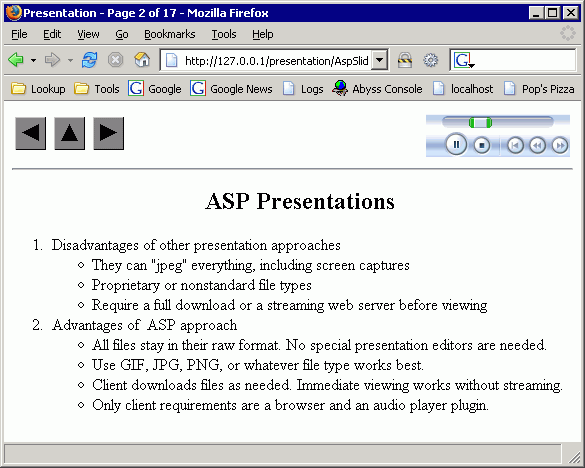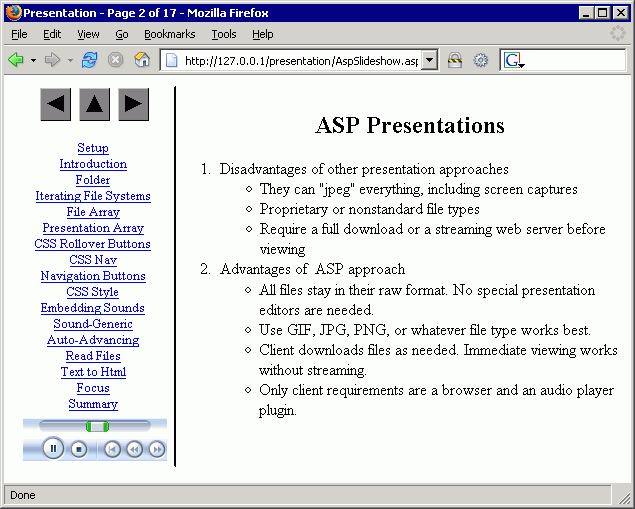
|
ASP Slideshow
|
Create
a self-advancing slideshow with no programming! I offer two
versions of the ASP slideshow. Both have the same name. It's up to you
to rename the files or store them in separate folders. Click the
screenshot of the version you want. A description of the ASP slideshow
is below the two screenshots.
Top Navigation

Left Navigation

Description
You put text and/or picture and/or sound files in the same folder
with the ASP script on your server. Make sure all related files have the same
base name (like "flower.jpg" and "flower.txt"). The script will find all
related files, sort them, and display each related group of files as a slide in
a presentation. Let me say this another way... All you have to do is supply the
raw files. A picture, a plain-text file, a sound, or all three. Or two out of
three. Whatever you have. You don't have to create web pages or write any
scripting. You don't need to know HTML or programming. All you have to do is
give your files meaningful and related names, stick some numbers on the front
of the file names so they'll sort into the right order, and upload them to your
Windows web server.
The "Left Navigation" version creates links to each slide. The link text
matches the file name minus the extension and any leading numbers, dashes, and
underscores. The "Top Navigation" version does not create links for
individual pages. Other than that difference, the scripts are the same. It's a
tradeoff between more room with the "Top Navigation" version or better
navigation with the "Left Navigation" version.
The generated web pages use client-side JavaScript, but will still work with
client-side scripting disabled (unless your browser -- like FireFox -- requires
you to have scripting enabled in order to display a sound plugin). The
generated web pages use CSS to make the navigation buttons look pretty, but
they'll work without CSS.
On Internet Explorer with scripting enabled, slides that have sounds will
automatically advance to the next slide as soon as the sound finishes playing.
If you're lacking IE, scripting, or sound, then you'll just press the "Next"
navigation button to advance to the next slide. NOTE - The IE auto-advance
feature works by detecting when the media player plugin goes from the "playing"
state to the "stopped" state. This happens at the end of the sound, but it will
also happen if you push the media player "stop" button! If you want to stop the
media player for any reason, you should always hit the "pause" button (two
vertical bars) first.
For all browsers, if scripting is enabled, focus moves to the "Next" navigation
button one second after the page loads, so you can use your "Enter" button to
go to the next page and your "Backspace" button to go back. For maximum
visibility, you might want to tell your viewers to press "F11" (in FireFox and
IE, at least) to view the presentation fullscreen. The presentation does NOT
attempt to resize the client browser.
There are a few constants in the ASP file you can edit (using Notepad) to
customize things a bit. They're all listed at the very beginning of the file so
you'll have no trouble finding them. Note that you don't need to change these
constants! The presentation should work fine in most cases just the way it is.
Here's a sample of what you're likely to find as the default constants:
Const PRESENTATION_TITLE = "Presentation"
Const HOME_PAGE = "../"
Const END_PAGE = "../"
Const IMAGE_ALIGN = "right"
Const TEXT_EXTENSIONS = "txt"
Const PICTURE_EXTENSIONS = "bmp, jpg, jpeg, gif, png"
Const HTM_EXTENSIONS = "htm"
Const SOUND_EXTENSIONS = "mid, wma, au, wav, mp3"
Const BACK_BUTTON = "◄"
Const HOME_BUTTON = "▲"
Const NEXT_BUTTON = "►"
PRESENTATION_TITLE
Scroll up and look at the screen captures. Notice the title
bar says "Presentation - Page 2 of 17". It'll say that (except for different
page counts) on every slide in your slide show. You can replace the word
"Presentation" with whatever may be more appropriate.
HOME_PAGE
If you hit the "Home" button (the center navigation button),
this is where you'll go. You can use relative or absolute URLs here. You should
choose a URL that is NOT part of the presentation.
END_PAGE
Here's where you go when you run off the end of the
presentation. Like hitting the "Back" when you're at the beginning or
"Next" when you're already at the end. Warning... Internet Explorer with
scripting enabled will automatically advance off the end of the presentation.
So if you decide that the END_PAGE should point back to the first page in the
presentation, you'll trap poor IE users in an endless loop. In most cases,
the END_PAGE should be the same URL as the HOME_PAGE.
IMAGE_ALIGN
If you have an image and text that will be displayed on the
same slide, the ASP script needs to know how to arrange them. I strongly
recommend using "right" here because IE does a really horrible job of wrapping
text around images. If the image is pushed to the right (like I suggest), then
text -- even with IE's bad wrapping -- will always be visible. Under FireFox,
I've snuck in an invisible image to force the text to break below the image if
there's less than 150 pixels on the side for the text. On either browser, if
you choose "left" for the IMAGE_ALIGN property, a large image might hide part
of your text off the right side of your screen. Not good.
TEXT_EXTENSIONS
When the ASP script is looking for text to wrap around a
picture, it will look for text files with these extensions. I can't imagine
using anything other than "txt". You should only use plain text files here!
That means no Word documents, no RTF files, and no HTM files. If you can't view
the file correctly in the "Notepad" program, it shouldn't be on this list.
PICTURE_EXTENSIONS
When the ASP script is looking for pictures to display in a
slide, it will look for image files with these extensions. If (because you're
doing some tricky things) you have multiple files with similar names like
"flower.jpg" and "flower.png", the file with the extension on the right
will be selected. In this case, since the default list is "bmp, jpg, jpeg, gif,
png", and "png" is further right than "jpg", then the "flower.png" image would
be used to build the slide and "flower.jpg" would be ignored.
Always try to keep your images small enough to fit on the
viewer's browser! You'll have to decide how big this is based on which ASP
script you're using (top or side navigation) and on whether you want to leave
room for text to be wrapped around the image.
HTM_EXTENSIONS
Amazingly, htm files can be handled just like pictures. By
default, I only have "htm" in the list, but you could add "html" if you wanted.
I prefer not to add "html" because I want to be able to use an index page that
won't be part of the slide show. By leaving "html" out of the list, I can have
an "index.html" file. One thing you should never do is add "asp" to the list!
If you do, the ASP script will try (and fail miserably) to add itself to your
presentation.
So -- How do I add an "htm" file as a picture? Well, I read
the HTM file and throw away everything that isn't inside the <body> tags.
I then stick that into the slide. Pretty simple. This allows you to create an
HTM file that may display multiple pictures or an animation or something the
ASP script couldn't handle alone. Because I only use the "body" of the HTM
file, you'll want to be sure any scripts or meta tags you really need are in
the body. You may hate doing it, but it will work, so you'll get over it.
SOUND_EXTENSIONS
When the ASP script is looking for sounds to play in a
slide, it will look for sound files with these extensions. If (because you're
doing some tricky things) you have multiple files with similar names like
"flower.wav" and "flower.mp3", the file with the extension on the right
will be selected. In this case, since the default list is "mid, wma, au, wav,
mp3", and "mp3" is further right than "wav", then the "flower.mp3" sound would
be played for the slide and "flower.wav" would be ignored.
Keep in mind that IE will auto-advance to the next slide as
soon as the sound finishes playing. So if you have a sound, it should be some
decent narration, not just a silly click sound. If there is no sound -- or if
the client browser can't play sounds -- then the client browser can dally as
long as they like before pressing the "Next" button to go to the next slide.
BACK_BUTTON
Here's where you decide what the "Previous" navigation
button should look like. The default is a left-pointing triangle generated with
a unicode character. A button effect is created with CSS code. The
button can also be plain text or can be a full graphic image tag. Here's a few
alternatives:
Const BACK_BUTTON = "<img border=0 src=http://www.w3.org/Icons/back.gif>"
Const BACK_BUTTON = "<"
Const BACK_BUTTON = "Back"
HOME_BUTTON
Here's where you decide what the "Home" navigation button
should look like. The default is a up-pointing triangle generated with a
unicode character. A button effect is created with CSS code. The button
can also be plain text or can be a full graphic image tag. Here's a few
alternatives:
Const HOME_BUTTON = "<img border=0 src=http://www.w3.org/Icons/house.gif>"
Const HOME_BUTTON = "^"
Const HOME_BUTTON = "Home"
NEXT_BUTTON
Here's where you decide what the "Next" navigation button
should look like. The default is a right-pointing triangle generated with a
unicode character. A button effect is created with CSS code. The button
can also be plain text or can be a full graphic image tag. Here's a few
alternatives:
Const NEXT_BUTTON = "<img border=0 src=http://www.w3.org/Icons/forward.gif>"
Const NEXT_BUTTON = ">"
Const NEXT_BUTTON = "Next"
Sample Shows
http://www.ericphelps.com/linux/bootdisk/
This ASP script is featured at:
ScriptSearch.com under the
ASP -- Scripts_and_Components -- Image_Galleries category as the
"ASP Slideshow".
ASP Resource Index under the
Tutorials & Code Snips -- Graphics & Charts category as the
"ASP Slideshow".
Planet Source Code under the
ASP/VBScript -- Graphics/Sound category as the
"ASP Slideshow".
HotScripts.com under the
ASP -- Scripts and Components -- Image Manipulation -- Slide Shows category
as the "ASP Slideshow".
Lost? Look at the site map.
Bad links? Questions? Send me mail.



